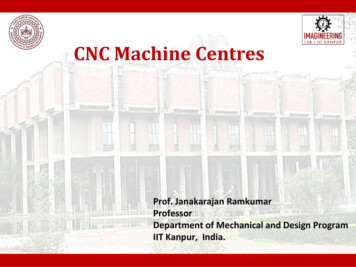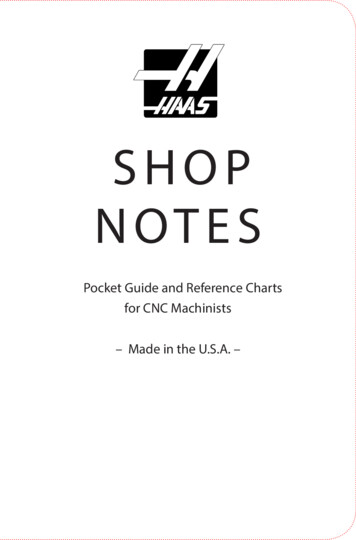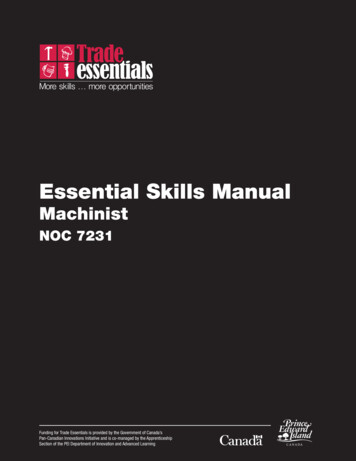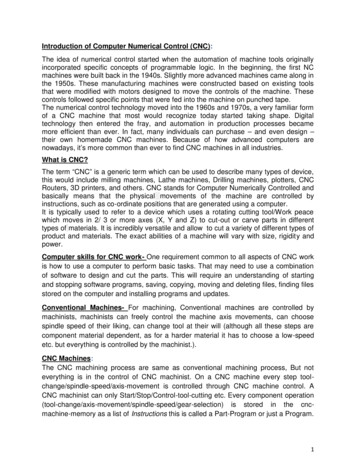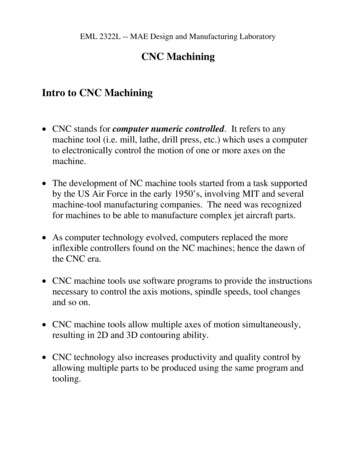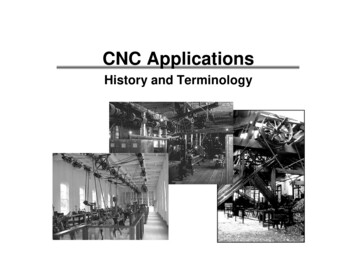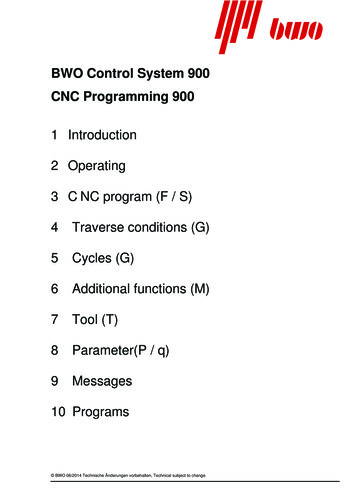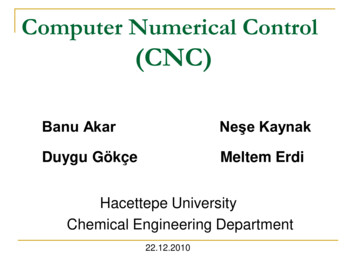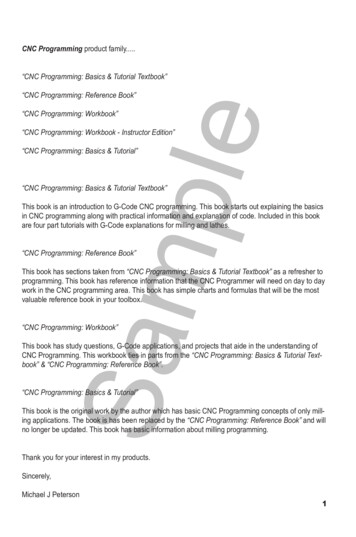
Transcription
CNC Programming product family.“CNC Programming: Basics & Tutorial Textbook”ple“CNC Programming: Reference Book”“CNC Programming: Workbook”“CNC Programming: Workbook - Instructor Edition”“CNC Programming: Basics & Tutorial”“CNC Programming: Basics & Tutorial Textbook”SamThis book is an introduction to G-Code CNC programming. This book starts out explaining the basicsin CNC programming along with practical information and explanation of code. Included in this bookare four part tutorials with G-Code explanations for milling and lathes.“CNC Programming: Reference Book”This book has sections taken from “CNC Programming: Basics & Tutorial Textbook” as a refresher toprogramming. This book has reference information that the CNC Programmer will need on day to daywork in the CNC programming area. This book has simple charts and formulas that will be the mostvaluable reference book in your toolbox.“CNC Programming: Workbook”This book has study questions, G-Code applications, and projects that aide in the understanding ofCNC Programming. This workbook ties in parts from the “CNC Programming: Basics & Tutorial Textbook” & “CNC Programming: Reference Book”.“CNC Programming: Basics & Tutorial”This book is the original work by the author which has basic CNC Programming concepts of only milling applications. The book is has been replaced by the “CNC Programming: Reference Book” and willno longer be updated. This book has basic information about milling programming.Thank you for your interest in my products.Sincerely,Michael J Peterson1
pleSamCNC ProgrammingBeginning Basics of G-CodeTextbook7
Table of Contents112333Introduction to G-CodeStandard M-Codes3965The Control PanelProgramming Basics7789pleIntroduction to CNC2 Axis FundamentalsCartesian Coordinate Systems149Lathe MachiningPart3 TutorialPart4 1199207213SamThe ToolpathMilling MachiningPart1 TutorialPart2 TutorialHelical InterpolationThread Milling1031131171419
pleSamIntroduction to CNC11
Introduction to CNCCNCFrom Wikipedia, the free encyclopediapleThe abbreviation CNC stands for computer numerical control, and refers specifically to a computer“controller” that reads G-code instructions and drives a machine tool, a powered mechanical devicetypically used to fabricate components by the selective removal of material. CNC does numericallydirected interpolation of a cutting tool in the work envelope of a machine. The operating parameters ofthe CNC can be altered via software load program.CNC was preceded by NC (Numerically Controlled) machines, which were hard wired and their operating parameters could not be changed. NC was developed in the late 1940s and early 1950s byJohn T. Parsons in collaboration with the MIT Servomechanisms Laboratory. The first CNC systemsused NC style hardware, and the computer was used for the tool compensation calculations andsometimes for editing.Punched tape continued to be used as a medium for transferring G-codes into the controller for manydecades after 1950, until it was eventually superseded by RS232 cables, floppy disks, and now iscommonly tied directly into plant networks. The files containing the G-codes to be interpreted by thecontroller are usually saved under the .NC extension. Most shops have their own saving format thatmatches their ISO certification requirements.SamThe introduction of CNC machines radically changed the manufacturing industry. Curves are as easyto cut as straight lines, complex 3-D structures are relatively easy to produce, and the number of machining steps that required human action has been dramatically reduced.With the increased automation of manufacturing processes with CNC machining, considerable improvements in consistency and quality have been achieved with no strain on the operator. CNC automation reduced the frequency of errors and provided CNC operators with time to perform additionaltasks. CNC automation also allows for more flexibility in the way parts are held in the manufacturingprocess and the time required to change the machine to produce different components.In a production environment, a series of CNC machines may be combined into one station, commonlycalled a “cell”, to progressively machine a part requiring several operations. CNC machines today arecontrolled directly from files created by CAM software packages, so that a part or assembly can godirectly from design to manufacturing without the need of producing a drafted paper drawing of themanufactured component. In a sense, the CNC machines represent a special segment of industrialrobot systems, as they are programmable to perform many kinds of machining operations (withintheir designed physical limits, like other robotic systems). CNC machines can run over night and overweekends without operator intervention. Error detection features have been developed, giving CNCmachines the ability to call the operator’s mobile phone if it detects that a tool has broken. While themachine is awaiting replacement on the tool, it would run other parts it is already loaded with up tothat tool and wait for the operator. The ever changing intelligence of CNC controllers has dramaticallyincreased job shop cell production. Some machines might even make 1000 parts on a weekend withno operator, checking each part with lasers and sensors.13
Introduction to CNCTypes of instructionA line in a G-code file can instruct the machine tool to do one of several things.MovementspleThe most basic motion for a controller is to move the machine tool along a linear path from one pointto another. Some machine tools can only do this in XY, and have to accept changes in Z separately.Some have two further axes of rotation to control the orientation of the cutter, and can move themsimultaneously with the XYZ motion. Lately 4 and 5 axis machines have become popular. The 2 additional axis allow for the work surface or medium to be rotated around X and Y. For example, a 4-axismachine can move the tool head in XY and Z directions, and also rotate the medium around the X orY axis, similar to a lathe. This is called the A or B axis in most cases.All motions can be built from linear motions if they are short and there are enough of them. But mostcontrollers can interpolate horizontal circular arcs in XY.Lately, some controllers have implemented the ability to follow an arbitrary curve (NURBS), but theseefforts have been met with skepticism since, unlike circular arcs, their definitions are not natural andare too complicated to set up by hand, and CAM software can already generate any motion usingmany short linear segments.SamWith the advent of the vortech router cnc quad drive system which utilizes four (bidirectional) motorsand drive, users are able to achieve greater speeds and accuracy.DrillingA tool can be used to drill holes by pecking to let the swarf out. Using an internal thread cutting tooland the ability to control the exact rotational position of the tool with the depth of cut, it can be used tocut screw threads.Drilling cyclesA drilling cycle is used to repeat drilling or tapping operations on a workpiece. The drilling cycle accepts a list of parameters about the operation, such as depth and feed rate. To begin drilling any number of holes to the specifications configured in the cycle, the only input required is a set of coordinatesfor hole location. The cycle takes care of depth, feed rate, retraction, and other parameters that appear in more complex cycles. After the holes are completed, the machine is given another commandto cancel the cycle, and resumes operation.Parametric programmingA more recent advancement in CNC interpreters is support of logical commands, known as parametric programming. Parametric programs incorporate both G-code and these logical constructs to create a programming language and syntax similar to BASIC. Various manufacturers refer to parametricprogramming in brand-specific ways. For instance, Haas refers to parametric programs as macros.GE Fanuc refers to it as Custom Macro A & B, while Okuma refers to it as User Task 2. The programmer can make if/then/else statements, loops, subprogram calls, perform various arithmetic, andmanipulate variables to create a large degree of freedom within one program. An entire product line ofdifferent sizes can be programmed using logic and simple math to create and scale an entire range ofparts, or create a stock part that can be scaled to any size a customer demands.14
Introduction to CNCpleParametric programming also enables custom machining cycles, such as fixture creation and boltcircles. If a user wishes to create additional fixture locations on a work holding device, the machinecan be manually guided to the new location and the fixture subroutine called. The machine will thendrill and form the patterns required to mount additional vises or clamps at that location. Parametricprograms are also used to shorten long programs with incremental or stepped passes. A loop can becreated with variables for step values and other parameters, and in doing so remove a large amountof repetition in the program body.Because of these features, a parametric program is more efficient than using CAD/CAM software forlarge part runs. The brevity of the program allows the CNC programmer to rapidly make performanceadjustments to looped commands, and tailor the program to the machine it is running on. Tool wear,breakage, and other system parameters can be accessed and changed directly in the program, allowing extensions and modifications to the functionality of a machine beyond what a manufacturer envisioned.SamThere are three types of variables used in CNC systems: Local variable, Common variable, andSystem variable. Local variable is used to hold data after machine off preset value. Common variableis used to hold data if machine switch off does not erase form data. The System variable this variable used system parameter this cannot use direct to convert the common variable for example Toolradius, Tool length and tool height to be measured in mm or inches.15
Introduction to CNCSampleThere are other codes; the type codes can be thought of like registers in a computer X absolute position Y absolute position Z absolute position A position (rotary around X) B position (rotary around Y) C position (rotary around Z) U Relative axis parallel to X V Relative axis parallel to Y W Relative axis parallel to Z M code (otherwise referred to as a “Miscellaneous” function”) F feed rate S spindle speed N line number R Arc radius or optional word passed to a subprogram/canned cycle P Dwell time or optional word passed to a subprogram/canned cycle T Tool selection I Arc data X axis J Arc data Y axis. K Arc data Z axis, or optional word passed to a subprogram/canned cycle D Cutter diameter/radius offset H Tool length offset18
Fundamentals of G-Code2 Axis FundamentalsConnect-the-dotspleG-Code programming is a very simple programming language. When we were kids, we used to andmay still do connect the dot puzzle games. G-code works exactly on the same principle. It takes twosimple concepts to understand G-code programming, connect-the-dots and the number line.We can draw something very simply by connecting the dots.We do not think about it, but we are creating something tangible in the2-axis world.The Number LineSamThe number line is simply the measurement of units. Let’s look at this number line:-2-1012In a straight line numbers either get bigger or smaller from Zero. Machining, along with G-Code programming, uses both sides of Zero.Signs / -The Plus ( ) sign and the Minus (-) sign are very important in machining. In machining we can alsocall them Positive or Negative respectively. We use these signs in two situations; location and direction.LocationThey signify what side of Zero a number is on, we can say this is a location indicator; Left for Minusand Right for Positive respectively from Zero.DirectionThese signs also are used as a tool to tell us which direction to move; Left for Minus and Right forPositive.25
Introduction to G-CodeStandard G-Codes - MillThe G-Codes are what tell the machine to do with positional reference. This is just a simple referenceto what standard G-Codes do.pleG0 or G00 – Rapid MovementThe fastest the Machine can go to the next defined position. If moving in multiple axis, each axis willmove as fast as they can independently of one another until it reaches it’s defined end points.G1 or G01 – Linear MovementA straight line move with a speed defined by an F. If moving in multiple axes, the machine will moveproportionally in each axis until it reaches its defined end position.G2 or G02 – Interpolation ClockwiseA circular movement in 2 axis. Will create an arc to a specified radius defined by R or I/J.G3 or G03 - Interpolation Counter ClockwiseA circular movement in 2 axis. Will create an arc to a specified radius defined by R or I/J.G4 or G04 – DwellMachine will dwell once reached position to a user defined time, P.G20G21SamG9 or G09 – Exact Stop/Exact PositionMachine will not traverse to next line of code until it positions exactly to position.G10- Data SettingG17- XY plane selectionG18- ZX plane selectionG19- YZ plane selection- Machine in inch- Machine in MMG28- Return to Reference PositionNormally machine home.G30 - Return to 2nd reference positionNormally pallet changing/tool change home if different than machine home.G40G41G42G43G44G49- Cutter Compensation Cancel- Cutter Compensation LeftUsed with user defined value, D- Cutter Compensation RightUsed with user defined value, D- Tool Length Compensation Used with user defined value, H. Common- Tool Length Compensation Used with user defined value, H. Not common- Tool Length Compensation Cancel43
Part1 TutorialPart1 TutorialThis is a sample part tutorial to begin basic milling programming. Included is a sample print, Part1,and a G-Code program to make the part.pleThe following is a detailed explanation of a standard Fanuc programmed part.This program is a Milling program, programmed to the side of the tool.The Part Zero for programming purposes of this part are:X0 Left Edge of PartY0 Bottom Edge of PartZ0 Top of Part* Refer to print on following page.Sam***All Feeds and Spindle speeds and reference information are from the book“CNC Programming - Reference Book”117
SamplePart1 TutorialMaterial: Aluminum 6061118
Part1 TutorialG-Code Program%O0001(PROGRAM#)(PROGRAM NAME - PART1)(SAMPLE PART)pleN1( 1” FLAT ENDMILL TOOL .J.5G1G40X-1.G0Z.1G0Z.1M9G91G28Z0M19M1N5( #U DRILL TOOL, .368)(.375 DRILL)T5M6M1N2(5/8 SPOT DRILL TOOL 2500M3 1(.375 (.375 REAMER TOOL, .375)(.375 3( 27/64 DRILL TOOL)G98G85Z-1.2R-.4F10.(1/2-13 75Y1.S2264M3 G91G28Z0M19M1(FINISH WALL .25G2X1.25Y-2.I-2.25G1G40Y-2.5G0Z.1(FINISH WALL STEP 1.25Y-1.25I-1.5G1G40Y-1.75G0Z.1(FINISH 25Y-.5I-.75G1G40Y-1.N4(1/2-13 CUT TAPRH TOOL .35R.1F10.G80Z.1M9G91G28Z0M19M1119
This book has sections taken from “CNC Programming: Basics & Tutorial Textbook” as a refresher to programming. This book has reference information that the CNC Programmer will need on day to day work in the CNC programming area. This book has simple charts and formulas that will be the most
